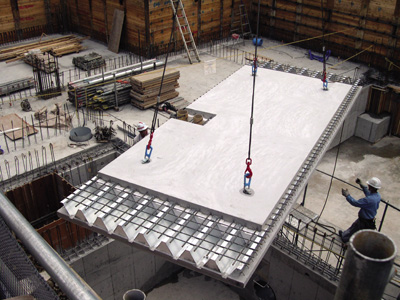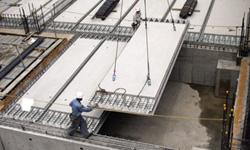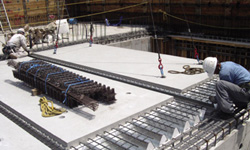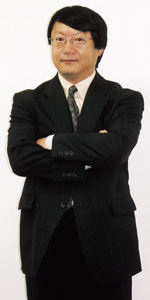Asahi Danke's UniSlab
Back to Contents of Issue: August 2004
|
|
|
|
by By John Dodd |
|
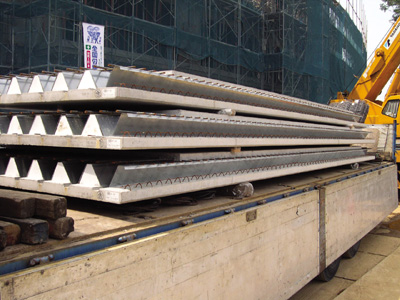 As canny small cap investors in the Japanese stock market know, some of the best deals are to be had in seemingly mundane industries--especially if the company being considered for investment is headed by a thinker and leader who is intent on turning their industry upside down. Concrete construction materials is just such an industry.
Asahi Danke is a small but growing construction materials and civil engineering company based in Asahikawa, Hokkaido. Established over 50 years ago, the founding family is now into its third generation at the helm. While Japan is dotted with such companies, with their stable and loyal work forces in the historically robust public works business, times are changing and only a few such firms are expected to survive. One of them is Asahi Danke--a company notable for both its technology and the quality of its young CEO, Katsuhisa Yamashita.
A revolution in the making
This technology is called UniSlab.
Conventionally, companies use precast concrete slabs or cast them in situ. The sheer weight and volume of material involved to achieve the necessary structural strength is a major contributor to the long lead times and costs of putting up a concrete building. Yamashita's innovation has been to develop a flooring slab which is both lightweight (about 50 percent lighter than an equivalent concrete slab) and can be used in universal installations--and is also portable and pre-formed to reduce the labor at the construction site.
He achieved this by developing a unique combination of folded, welded steel structures--using automobile welding technology--interlaid with concrete and other materials. Although deceptively simple in concept, UniSlab is a unique product in the market, and in the just 24 months since the product was announced, Asahi Danke's sales of it have already risen to 4 percent of the company's overall JPY11 billion ($100 million) in sales. Yamashita sees the sales for UniSlab taking off early next year after a new and even easier to use version is released in the market in September.
How good is the UniSlab technology? The current popular method for the Japanese construction industry is to construct Deck Plates, basically the fitting of either con- ventional pre-formed or site-formed concrete slabs. The problem is that these slabs are extremely heavy and require large cranes and teams of workers to install. An average construction crew can install about 20 such deck plates a day--roughly one floor of a mid-sized building. By contrast, the same crew, with appropriate training, can install up to 100 similarly sized slabs in the same period. And on top of the productivity gains, UniSlab products are cheaper than regular concrete to both produce and to transport.
Performance improvements of 50 percent or more are naturally making the construction industry sit up and take notice. Japanese construction firms are notoriously conservative--and Asahi Danke is trying to tilt at some major incumbents. Nevertheless, Yamashita says that most of Tokyo's major general contractors have already tested UniSlab, and the number planning to use it in new buildings over the next two years is rapidly increasing.
Even the media have been helpful. Usually industry journals on construction are somewhat dry, so Yamashita has been working the journalists with promises of new concepts that will change the industry. The result has been some excellent coverage--and of course resulting sales.
One problem slowing the adoption of UniSlab has been the unfamiliarity of contractors with how to join the slabs together and tether them to the building structure. Yamashita is therefore planning to launch later this year a new jointing system for his slabs which will allow contractors to "lock" the units into a framework quickly, easily and securely.
Another problem to be is that while the UniSlab system is patented, it is also surprisingly simple--applying steel backbone structural techniques to concrete slabs--and thus competitive products are bound to turn up in the market.
Anticipating such developments, Yamashita feels he has two advantages. First, he and his team spend a lot of time receiving feedback from contractors about what they really want the system to do--and thus the resulting refinements are numerous and subtle. Second, he has a slew of other new products and processes in the pipeline, starting with the slab jointing system at the end of this year, and followed by other products, including a new lightweight wall-cladding system with superior thermal insulation properties.
Yamashita's product development vision is to create a series of Lego-like components for construction firms to use in small to medium-sized buildings--particularly apartment complexes and offices. As he told us, "I would like to create several lines of products, allowing contractors to match performance with price. This approach is similar to what Toyota does for consumers, offering the same functionality in different packages. Eventually, we want to become the Toyota of the construction materials industry."
Company profile
Consolidating the sales of Asahi Danke with its three affiliated companies results in a total revenue for fiscal year 2003 of JPY10.9 billion ($99 million), with profits of just JPY100 million ($900,000).
We asked Yamashita about the low profit level and what he plans to do about it. His response? "Due to a change in government attitudes about public construction projects, most smaller firms in the industry are posting rather negative results, so the fact that we are in the black at all is not such a bad situation."
But then we discover where the profits are going: as he refers to the new push within the business, Yamashita adds "However, the low profit also highlights the need for us to drive new business through technology and innovation. I have been deliberately applying the company's resources to intensive R&D, so as to slingshot us into a much better situation three to four years from now. We're already seeing the results of this effort, with an 8 to 10 percent improvement in profits over fiscal year 2002."
We asked Yamashita about his expectations for sales growth over the next five years. He shared with us that to achieve his goal of doubling sales until 2009, he is using both technology and organic but modular growth. The company has 13 factories in four major regions/locations: Asahikawa, Doutou, Sapporo and Tokyo. The regional division of the company is necessary because concrete products are both heavy and bulky to transport.
Yamashita says that each region is able to produce sales of JPY2.5 to JPY3 billion respectively, and thus internally the company management use a rule of thumb that a new region can produce JPY3 billion of sales a year. Furthermore, the individual factories in each location have an output of about JPY500 million a year each. So to increase sales, the company tries to develop sufficient business in a particular region to support at least one factory. Once a factory is running, revenue jumps up by another increment of JPY500 million.
It's a simple but safe process of growth and one that could probably see the company through another 50 years. However, Yamashita wants to speed things up. Over the last two years he has been investing in increasingly more sophisticated plant equipment to produce the UniSlab panels. As we noted, he borrows production line technology from the auto industry to produce the UniSlab product on a mass basis. This involves sophisticated welding machines and a movable production line. He has also developed some interesting processes and vibratory equipment for settling concrete and concrete composites into the steel skeletons that form the base of each UniSlab panel.
R&D is a major factor in the company's recent success, and Yamashita plans to keep the pressure on. In a company of just 140 people, having more than 40 research and engineering staff means a surprisingly high percentage is devoted to expertise--far ahead of others in the industry. Seventy percent of the R&D team are located in Hokkaido, mainly focusing on civil engineering, while the remaining 30 percent are in Tokyo focusing on building construction. Yamashita is successful in attracting young engineers; the average age of the Tokyo team is about 35. And Yamashita himself has relocated to Tokyo to spearhead the push in construction and to be closer to where the deals are made.
A CEO for the 21st century
During his university years, Yamashita discovered his love of engineering and creating new ideas. However, his father insisted that he become a businessman first, and sent him off to work in a company called Kuwazawa that traded construction materials and equipment in Hokkaido.
Conditions at the trading company were tough, but it provided the younger Yamashita with valuable commercial experience, including taking the lead in preparing the company for an IPO. When Yamashita turned 35, his father decided it was time for him to enter the family business. He was hired as a junior manager.
Asahikawa, where the headquarters for Asahi Danke is located, is a very tight-knit rural community. Although he was the boss's son, Yamashita knew on entering the company that he had to prove himself. Business was good thanks to the largesse of the government, but inventory control and procurement standards were underdeveloped.
Yamashita therefore decided to take charge of computerizing the company--an activity that took him into the minutae of the finances and running of the company and gradually earned him the respect of the other employees. He developed his own software, upgraded the accounting systems, studied how to apply computers to design and R&D and basically started reinventing the company. At 45 he became the CEO and his father retired, leaving Yamashita to control the destiny of the family fortune.
Indeed, it would have been quite easy for Yamashita to rest on his laurels and lead a comfortable life in Hokkaido. But in 1992, he and his father decided Asahi-Danke had to go public to gain some internal discipline and raise money to grow the business. Typically, when Yamashita was told by Nomura that someone from the firm had to receive training at Nomura's pre-IPO training center in Tokyo, he took a month's sabbatical and received the training himself. The IPO was a success, and the company listed on the JASDAQ stock exchange.
Yamashita now appears to have set a pattern for being both the instigator and implementer of the company's innovation and development. After he took over the firm from his father, he negotiated with the senior managers for them to take on more responsibility--thus softening the iron-fist rule of his father. He also buttressed the management team with the appointment of his younger brother into senior management. Eventually his brother will become the CEO.
At the same time, Yamashita relocated to Tokyo to push Asahi Danke's new product development. Most of the ideas that come out of the labs have thus far come from Yamashita, whose favorite ploy is to challenge his engineers to do something they think is impossible. He is very hands- on, touring his labs on a regular basis, providing input and making sure that people are being challenged and using information beyond just their own industry. He is also a voracious reader who each night studies a range of engineering and business texts to figure out where technology is going and how he can apply it to concrete.
We asked Yamashita about his focus on technology over conventional business competition, and his answer was: "My father was a businessman type. But I prefer R&D and technology. I believe that if we don't possess our own technology, then we will always have to follow other companies, and under the current economic climate, just making good quality products is not enough. With your own technology, you can sell on the merit of the products, not just rely on goodwill with long-term customers, many of whom are also under severe financial pressure. New ideas excite customers and make them willing partners rather than grudging consumers of the same old thing."
International opportunities
Already the company has had many inquiries about UniSlab from companies in Europe and America as well as in Asia. In particular, Chinese companies have shown keen interest in the system, since that country is now experiencing a construction boom. Among the Chinese contacts have been requests from major government-owned firms, who have already told Yamashita that within a few months they could give him sizeable market share in Shanghai and Beijing. However, like most inventors, Yamashita is taking a prudent approach, weighing his options and researching whether having aphysical presence or licensing is the way to go. He tells us that he welcomes inquiries from both investors and potential partners but wants to release his new jointing system this fall, before making any major moves.
What final observation does a thinker, leader and innovator have to share with us? A surprisingly conservative but reassuring one:
"While growth and success are important to me," he tells us, "it's equally important to remember that Asahi-Danke as a company has a responsibility. We were born of a small community in a challenging environment. We're the largest employer in that town and many local people have dedicated their lives to guarantee the success of the company. We, the management and owners, owe them something in return. My motivation to bring financial success to the company, is to allow both the employees and their families to lead better lives. It may sound a bit corny, but I have deep roots in that town and I care about it. Hopefully, my investors and partners will understand this commitment and find confidence in me as a result." @ |
|
Note: The function "email this page" is currently not supported for this page.


